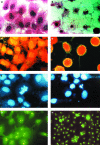Hepatic veno-occlusive disease as a result of a traditional remedy: confirmation of toxic pyrrolizidine alkaloids as the cause, using an in vitro technique
- PMID: 12194997
- PMCID: PMC1769740
- DOI: 10.1136/jcp.55.9.676
Hepatic veno-occlusive disease as a result of a traditional remedy: confirmation of toxic pyrrolizidine alkaloids as the cause, using an in vitro technique
Abstract
Background/aims: A child presented with hepatic veno-occlusive disease after having been administered a short course of treatment with a traditional herbal remedy. The child subsequently died. Postmortem liver histology confirmed the diagnosis. This study aimed to investigate the hypothesis that the herbal remedy was the cause of veno-occlusive disease.
Methods: Extracts of the traditional remedy were analysed by colorimetry and gas chromatography/mass spectrometry. Cultured hepatocytes were treated with an extract of the plant material and examined for morphological changes.
Results: The screening analyses indicated the presence of toxic pyrrolizidine alkaloids, which were later confirmed by gas chromatography/mass spectrometry. The cell studies indicated dose related toxicity, with necrosis at high concentrations and apoptosis and abnormalities of the cytoskeleton at lower concentrations.
Conclusions: The simple screening techniques used allowed rapid confirmation of the presence of toxic pyrrolizidines in the remedy. The in vitro method confirmed the toxicity of herbal extracts to hepatocytes.
Figures


References
-
- Hutchings A, Terblanche S. Observations on the use of some known and suspected toxic Liliiflore in Zulu and Xhosa medicine. S Afr Med J 1989;75:62–9. - PubMed
-
- Willmot FC, Robertson GW. Senecio disease or cirrhosis of the liver due to senecio poisoning. Lancet 1920;2:848–9.
-
- Freiman I, Schmaman A, Zamit R, et al. Veno-occlusive disease of the liver—some new aspects. S Afr Med J 1968;42:126–9. - PubMed
-
- Grobler A, Koen M, Brouwers F. Planttoksiene en lewersiektes by kinders in Pretoria en omgewing. Tijdschr Kindergeneeskd 1997;65:99–104.
Publication types
MeSH terms
Substances
LinkOut - more resources
Full Text Sources
Medical
